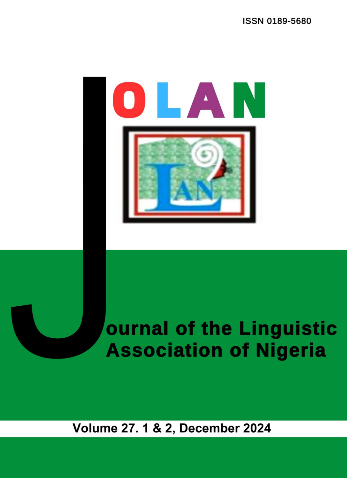Word-Based Hypothesis: Evidence from Hausa and Fulfulde Word Formation
Keywords:
Morphological Typology, Morphological Theory, Word Based Hypothesis, Word FormationAbstract
Hausa, the most important and best known Chadic language of Afro-asiatic (Newman 2009: 618) and Fulfulde, the most well-known language of West Atlantic of Niger Congo (Pulleyblank 2009: 858) are adjacent speech communities, genetically unrelated and are both found in Northern Nigeria and beyond. The paper is based on theoretical linguistic research which focuses on derivational morphology of Hausa and Fulfulde languages, using word-based hypothesis. The aim of the paper is to present Hausa and Fulfulde word formation to clarify the Aronoff’s (1976) notion on word-based hypothesis with the objectives of identifying the morphological typologies of each of the languages. The paper found out that language typology plays an important role on selection of morphological theory. Hence, Hausa and Fulfulde languages justify the claim about syntax and semantics of word formation more than a claim about affixation.
References
Abubakar, A. (2001). An Introductory Hausa Morphology. Maiduguri: Department of Languages and Linguistics, University of Maiduguri, Nigeria.
Ahmed, A. I. (2011). Introduction to Fulfulde Syntax. LINCOM EUROPA, Academic Publications.
Aminu, A. (2017a). Morphosyntactic Analysis of Fulfulde Voice and Tense in Adamawa Dialect: A Case Study of Yola South. In: Journal of the Linguistic Association of Nigeria, Vol. 20 No 2.
Arnott, D.W. (1974). Some Aspects of the Study of Fula Dialect. Bulleting of the School of Oriental and African Studies, University of London, Vol. 37 no. 1.
Aronoff, M. (1976). Word Formation in Generative Grammar. Linguistic Enquiry Monograph 1. Cambridge. MIT Press.
Aronoff, M. (1994). Morphology by Itself: Stems and Inflectional Classes. Massachusetts. Linguistic Inquiry Monographs; 22. MIT Press.
Aronoff, M. and Fudeman, K. (2011). What is Morphology. Second Edition. U.S.A. Blackwell Publishing.
Aikhenvald, Y.A (2007). Typological distinctions in word-formation. In: Timothy shopen (ed.). Language typology and Syntactic Description. Volume III: grammatical categories and Lexicon, 2nd Edition.
Bargery, G.P (1934).Hausa-English Dictionary and English-Hausa vocabulary. Zaria: Ahmadu Bello university Press, zaria, Nigeria.
Beard, R. (1981). The Indo-European Lexicon: A Full Synchronic Theory. Amsterdam. Linguistics Series, no. 44.
Bloomfield, M. (1933). Language. London. George Allen and Unwin Ltd.
Crystal, D. (2008). A Dictionary of Linguistics and Phonetics. Malden: Blackwell Publishing.
De St. Croix F.W (1998) Fulfulde–English Dictionary. Daudu, G.K. Abu-Manga, A. Mukoshy, I.A. and McIntosh, M.A (eds.) Centre for the Study of Nigerian Languages, Bayero University Kano, Nigeria.
Hockett, C. F. (1954). Two models of grammatical description.
Lieber, R. (1992). Deconstructing Morphology. Chicago. University of Chicago Press.
Newman, P. (2009). Niger Kordofanian (Niger Congo Languages). In: Comrie, B. (ed.) The World’s Major Languages. NY. Routledge.
Plag, I. (2003). Word-formation in English. Cambridge. Cambridge University Press.
Pulleyblank, D. (2009). Niger Kordofanian (Niger Congo Languages). In: Comrie, B. (ed.) The World’s Major Languages. NY. Routledge.
Schlegel, A.W.von (1818). Observations sur la langue et la littérature provençales. Paris.
Selkirk, E. (1982). The Syntax of Words. Cambridge. MIT Press.
Spencer, (2006). Morphological Universals. In: Mairal, R and Gil, J (Eds), Linguistic Universals. New York. Cambridge University Press.














